This Week in Space: Crickets, Cosmic Spiders, and More on Artemis
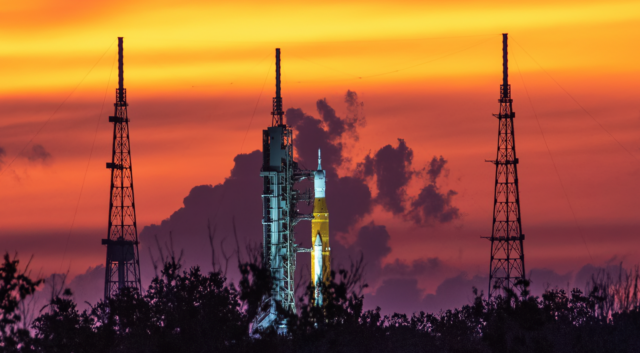
Good morning, everyone, and welcome to This Week in Space. Normally we’ve got a diverse set of space news and rocket launches to discuss. But since the Space Launch System (SLS) rocket’s inaugural launch was scrubbed twice last week, it’s like everyone at NASA is running around with their hair on fire. They’ve been mum since Saturday, and in the silence, you can practically hear crickets chirping. The media finally got a briefing update last night. We’ve also got an update from NASA’s DART asteroid mission. And we’ll also discuss reports that the James Webb telescope captured a “cosmic tarantula.”
This post is 100% free of actual spiders, we promise.
Artemis Hunting Ghosts in the System After Failed SLS Launch
After scrubbing multiple launches last week during countdown, NASA took a short pause on trying to launch the Artemis 1 mission. They’re chasing ghosts in the Space Launch System’s hydrogen cryofuel system. There are also cracks in the rocket’s insulating foam.
At first, everyone thought the Artemis team would have to roll the SLS rocket back to the Vehicle Assembly Building. That’s such an ordeal that it would have delayed the launch until at least well into October. However, the Artemis 1 team has chosen to make its repairs to the rocket’s hydrogen systems right there on the launchpad.
It makes sense; these problems happen when they try to go live. Hydrogen fueling is this rocket’s Achilles’ heel. Testing in situ lets the Artemis team hone right in with root cause analysis. And there’s no shortage of problems to solve. The agency has never completed a successful fueling test of the SLS. There’s a bad temperature sensor in one engine. The hydrogen fuel line got over-pressurized, which NASA is marking up as operator error. (They are, however, acknowledging that the administration rushed the operators, and rushing created problems.) And there’s a bad seal on the “quick disconnect” for the core stage’s hydrogen line. Let’s call it a target-rich environment.
Listen. All this intensive hydrogen troubleshooting is great. And the folks at NASA are legends for their resourcefulness. But I can’t be the only person who gets the bad kind of goosebumps when I hear “…a crack in the tank’s insulation.”
Do y’all know what a BLEVE is? It stands for Boiling Liquid Expanding Vapor Explosion. When you heat up a tank too far, the liquid inside can start to boil. It pressurizes the tank. When the tank finally lets go, the escaping gases can suddenly ignite in an explosion of remarkable force. And I get that I’m a layman here, but if the crack in the rocket’s fuel tank insulation exposes the tank to the heat of atmospheric drag. To paraphrase, you are having a bad problem, and you will not go to space today.
Oh Sure, Blame It On the Sensors
If you say “Senate Launch System” three times into a mirror, Richard Shelby (R-Ala) will appear and start defending the SLS’s viability in light of SpaceX’s clearly superior business proposition, and justifying the cost-plus contracts and mandatory fees issued to defense contractors like Boeing and Aerojet Rocketdyne. Besides, he’d say, it’s a jobs program.
The jobs part, at least, is true. The SLS created almost 25,000 jobs, distributed throughout all 50 states. (Never mind that over 13,000 of those jobs went to Alabama.) And we’re reusing the RS-25 engines from the Shuttle, which is great because they were supposed to be reusable. Except we’re “reusing” these RS-25 engines once for each SLS launch, and then throwing them out. So now, thanks to acts of Congress and their attendant defense-industry secret handshakes, Ars Technica wrote back in 2020: “NASA is spending at least three times more for an engine that was previously built for reuse, but now is expendable. And in the news release, Aerojet brags about reducing the price of these engines.” (emphasis original)
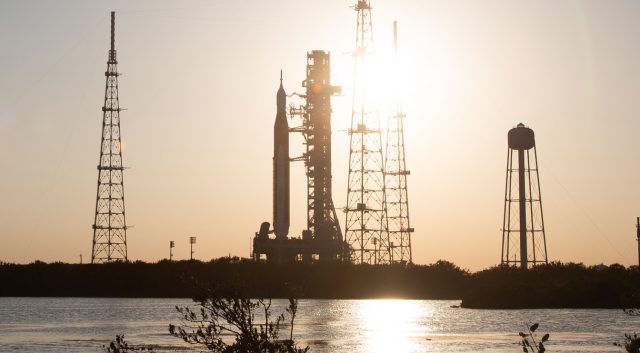
NASA’s Space Launch System (SLS) rocket with the Orion spacecraft aboard, atop a mobile launcher at Launch Complex 39B. Image: NASA/Joel Kowsky
Even lowball estimates peg the cost of a single SLS launch at upwards of $870 million. One analyst calculated that on the high end, an SLS launch could run $2 billion or more. Meanwhile, SpaceX’s Falcon Heavy can lift two-thirds of the SLS rocket’s throw weight, at one-twentieth the price per launch. SpaceX is also developing a super-heavy-lift rocket called Starship. It’ll be the tallest and most powerful rocket humans have ever built.
NASA already has plans to involve Starship in future Artemis missions. And the agency’s Commercial Cargo and Commercial Crew programs have long since been courting (and funding) private space companies. NASA’s long-term mission is to become “one of many” entities with a presence in orbit and on the moon.
‘You Don’t Want to Light That Candle Until It’s Ready’
NASA’s official YouTube channel currently has the moon rocket scheduled for another launch window that opens on Sept. 19. However, Jim Free, the agency’s associate administrator for exploration systems development, said today (Sept. 8) that the Artemis 1 moon mission could launch on Sept. 23 or Sept. 27. But the Kennedy Space Center is uncertain enough that the rocket will be ready that they’re pointedly not selling tickets.
Those launch dates depend on a whole array of conditions, including one that could delay the launch still further. NASA has to get an extension on the deadline for checking batteries on the rocket’s flight termination system (FTS), which is designed to destroy the rocket if it veers off course during launch. That’s right: this rocket actually has a self-destruct system. And the US Space Force requires NASA to test it every three weeks. However, that testing process would require the Artemis team to roll the SLS rocket back to the VAB. This would incur weeks of additional delay.
“We don’t launch until it’s right,” NASA administrator Bill Nelson said in a briefing after the agency first scrubbed the SLS launch, on August 29th. “You don’t want to light that candle until it’s ready to go.”
Webb Telescope Captures ‘Cosmic Tarantula’
In keeping with the James Webb space telescope’s spidery name, NASA and ESA officials announced this week that Webb has captured a ‘cosmic tarantula.’
NASA and the ESA both say that the image “resembles a burrowing tarantula’s home, lined with [its] silk.” (Personally, I think that’s a reach, but sure, let’s go with it.)
This ‘cosmic tarantula’ is actually a stellar nursery called 30 Doradus. It’s the largest and brightest star-forming region in the entire Local Group. It’s also home to some of the hottest, most massive stars in the visible universe. Researchers hope to use Webb’s exquisite resolution to study the region in detail, because its stellar chemistry may reveal insights about the early universe.
NASA Picks Axiom Space for First Artemis Space Suits
Earlier this summer, NASA picked two different companies to build next-generation space suits for future astronauts: Collins Aerospace and Axiom Space. The agency selected Axiom Space to build the suits that future Artemis III astronauts will wear. While Artemis II will have humans aboard, it will orbit the moon without touching down. Artemis III will be the first time humans set boots on the lunar surface in more than 50 years. According to NASA, this specific contract is worth $228.5 million. The space agency expects to award as much as $3.5 billion to Collins and Axiom to build space suits through 2034.
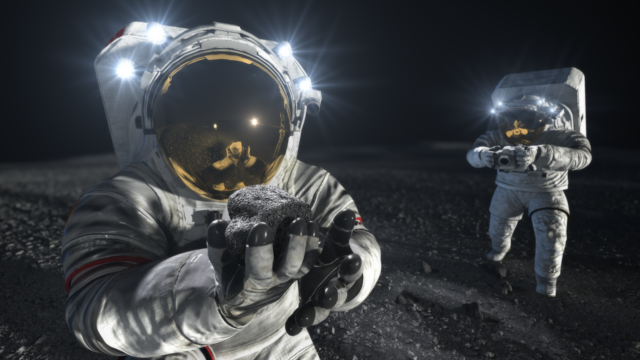
Image: NASA
“NASA is proud to partner with commercial industry on this historic mission that will kickstart the United States building a lasting presence on the surface of the Moon,” said the manager of NASA’s Extravehicular Activity and Human Surface Mobility program, Lara Kearney. “What we learn on Artemis III and future missions on and around the Moon will pave the way for missions to Mars. Spacesuits enable us to literally take that next step.”
NASA has already laid down the requirements and specifications for future manufacturers to achieve. Axiom Space will also have to test the suits in a space-like environment planet-side before they’re actually used for a mission. But the agency badly needs new space suits. The suits currently aboard the ISS are decades old. Suits intended for lunar EVA undoubtedly have some specific requirements, and there’s not a lot of Apollo-era hardware still in service. While we can all be very glad about that, it does mean NASA is starting from scratch.
DART Glimpses Its Final Destination
In just under three weeks, NASA’s Double Asteroid Redirection Test (DART) will slam a 1,340-pound weight into a small moon to see what happens. DART is heading for the double asteroid Didymos and its tiny moonlet, Dimorphos. (NASA calls the moonlet ‘Didymoon.’ 💙) This week the DART probe caught the first glimpse of its target, or at least its target’s primary body. The following image is a composite of 243 separate images, courtesy of DART’s camera, the Didymos Reconnaissance and Asteroid Camera for Optical navigation (DRACO).
“This first set of images is being used as a test to prove our imaging techniques,” said Elena Adams, the DART mission systems engineer at the Johns Hopkins Applied Physics Laboratory (APL) in Laurel, Maryland. “The quality of the image is similar to what we could obtain from ground-based telescopes, but it is important to show that DRACO is working properly and can see its target to make any adjustments needed before we begin using the images to guide the spacecraft into the asteroid autonomously.”
Smashing Things, For Science
While slamming heavy objects into asteroids is fun in any context, NASA has some practical science objectives it wants to accomplish. The question of whether we can deflect a potentially deadly asteroid before it strikes Earth is one of the “Low Likelihood / High Impact” type of events that keeps astronomers awake at night.
After DART hits Didymos, we’ll measure the results of the impact and how it changes Dimorphos’ orbit around Didymos. Earlier this summer, my colleague Ryan Whitwam discussed predictions that Dimorphos might resemble a loose rubble pile as opposed to a rocky body. If that’s true, DART’s impact could radically reshape or even destroy the moonlet. Regardless of the outcome, we’ll know more about the makeup of asteroids in orbit around the sun and what it might take to deflect one.
DART will continue to fine-tune its trajectory as it approaches Didymos with multiple orbital corrections over the next few weeks. NASA predicts the probe will reach its target on Sept. 26.
Skywatchers Corner
Tonight (Friday, Sept. 9), if you’re outside around 10 p.m. EDT, look to the southeast. Two big, bright points of light should be visible, one on either side of the nearly full moon: Jupiter and Saturn, escorting Luna through the night sky. And on the morning of the 11th, if you have clear weather, you can find the moon just a few degrees away from Jupiter in the sky. With a pair of binoculars, you might even be able to make out the gas giant’s four largest moons, as “little starlike points of light.”
Two weeks from today, the Northern Hemisphere will celebrate the autumn equinox. For those in the Southern Hemisphere, the September equinox marks the start of spring. The equinoxes are a twice-yearly celestial holiday, when the lengths of day and night are equal. But they don’t necessarily mean anything about the weather. The entire continental U.S. can back me up on this because we’re all broiling under yet another heat wave. It might be the autumn equinox in a couple of weeks, but that doesn’t mean the seasons have changed from summer to fall.
History and religion are full of solar and lunar holidays. But these days are more than just an excuse for a feast. Take note of exactly where the Sun appears to rise and set on the equinoxes. Those points mark the cardinal directions of due east and due west, respectively.
See you next week!

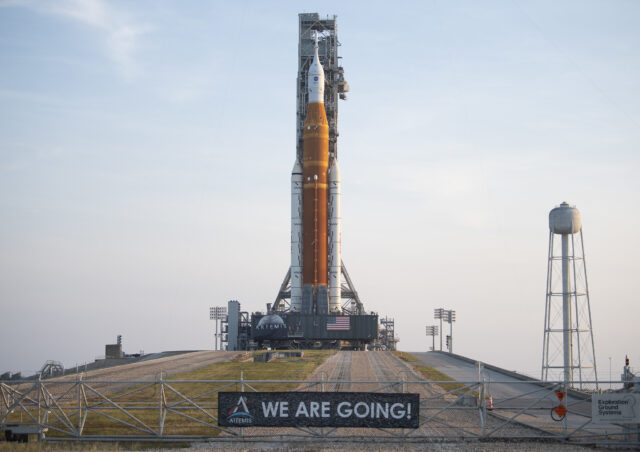
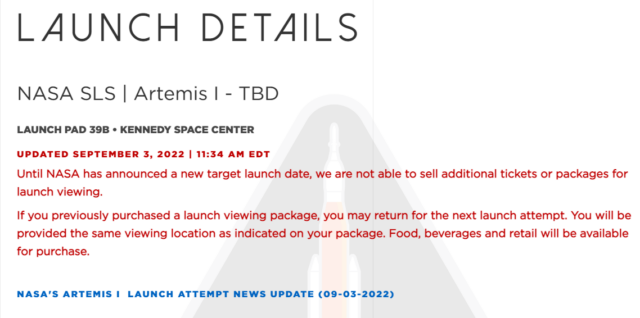

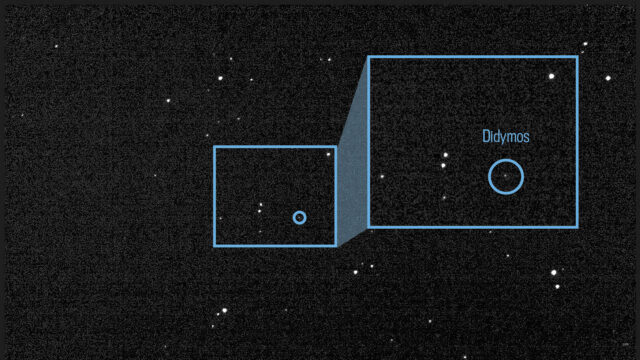
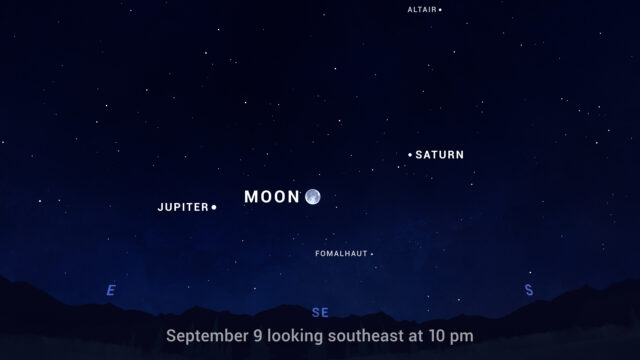
Comments are closed.